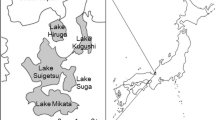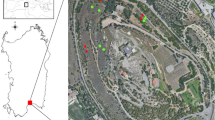Abstract
The production, density and environment of buried seeds and the temperature response of germinating seeds in Trapa natans var. japonica Nakai were ascertained. The mechanism of high reproductivity, tolerance of the plant for eutrophication and the stability of the stand in an eutrophic lake are discussed. The mean fresh weight of seeds was about 7.2 g, and the density of liver and dead seeds in April ranged 66.7 to 80.0 m-2 and 26.7 to 97.8 m-2, respectively. The threshold temperature that breaks dormancy and promotes germination in the lake was the low temperature, 8°C. The dormancy of buried seeds was almost broken under the field condition in January. The rate of germination obtained by the field experiment, and the estimation from the density of buried seed and the number of seeds germinated at the stand, were 87% and 60%, respectively. It was estimated that about 30% of the seedlings died before the floating leaf reached water surface. A rosette produced less than three seeds a year, which were fewer than for another Trapa, but the size of the former was larger. The number of seeds changed year by year, but the size-distribution pattern of seeds did not change with years, nor was it affected by the density of rosettes. The reason why T. natans var. japonica could succeed in eutrophic waters was attributed to reproductive strategy. The stand could recover by increasing the number of rosettes through the great branching ability of the main stem, even when the density of buried seeds was greatly decreased in the previous year.
Similar content being viewed by others
References
Cook, R. E. 1975. The photoinductive control of seed weight in Chenopodium rubrum L. Am. J. Bot. 62: 427–431.
Fenner, M. 1985. Seed ecology. Chapman and Hall, London.
Hayashi, K. 1983. Life cycles and mechanisms of population maintenance in floating-leaved annual plants. M.Sc. Thesis. Ibaraki University (In Japanese).
Hayashi, K. 1984. Life of annual floating-leaved plants. Iden (Heredity) 38: 6–11 (In Japanese).
Kitamura, S. & Murata, G. 1982. Colored illustrations of herbaceous plants of Japan. Revised Edition. Hoikusha Publishing, Osaka (In Japanese).
Kunii, H. 1983. Diurnal vertical fluctuation in some water variables under the covers of two different aquatic plants, Elodea nuttallii, and Trapa sp. Mem. Fac. Sci., Shimane Univ., 17: 61–69.
Kunii, H. 1988a. Seasonal growth and biomass of Trapa japonica Flerov in Ojaga-ike Pond, Chiba, Japan. Ecol. Res. 3: 305–318.
Kunii, H. 1988b. Longevity and germinability of buried seed in Trapa sp. Mem. Fac. Sci. Shimane Univ. 22: 83–91.
Midorikawa, B. 1959. Growth — analytical study of altherbosa on Mt.Hakkôda, North-East Japan. Ecol. Rev. 15: 83–117.
Momoshima, T. & Nakamura, D. 1979. Studies on water chestnut (Trapa natans L.). Bull. Saga. Agr. Exp. St. 19: 83–111 (In Japanese with English summary).
Muenscher, W. C. 1936. Storage and germination of seeds of aquatic plants. Bull. Cornell Univ. Agr. Exp. St. 652: 3–17.
Otaki, S. 1975. The distribution and the ecology of the aquatic plant in Chiba prefecture. In: Biological Society of Chiba Prefecture (ed.), Flora and vegetation of Chiba Prefecture, pp. 83–91. Inoueshoten, Tokyo (In Japanese).
Otaki, S. & Ishido, T. 1980. Illustrated Japanese water plants. Hokuryukan, Tokyo (In Japanese).
Ozawa, J. 1958. Test for the activity of a seed using reductionism. In: Seed of trees and its treatment, pp. 276–280. Japan Forest Technical Association, Tokyo (In Japanese).
Sculthorpe, C. D. 1967. The biology of aquatic vascular plants. Edward Arnold, London.
Terasawa, Y. 1927. Experimentelle Studien über die Keimung der Samen von Trapa natans L. Bot. Mag. Tokyo, 41: 581–588.
Tsuchiya, T. & Iwaki, H. 1979. Impact of nutrient enrichment in a waterchestnut ecosystem at Takahama-iri Bay of Lake Kasumigaura, Japan. II. Role of waterchestnut in primary productivity and nutrient uptake. Water Air Soil Pollut. 12: 503–510.
Tsuchiya, T. & Iwaki, H. 1983. Biomass and net primary production of a floating-leaved plant, Trapa natans, community in Lake Kasumigaura. Japan. Jpn. J. Ecol. 33: 47–54.
Wardlaw, I. F. & Dunstone, R. L. 1984. Effect of temperature on seed development in ojoba (Simmondsia chinensis (Link) Schneider). 1. Dry matter changes. Aust. J. Agric. Res. 35: 685–691.
Author information
Authors and Affiliations
Rights and permissions
About this article
Cite this article
Kurihara, M., Ikusima, I. The ecology of the seed in Trapa natans var. Japonica in a eutrophic lake. Vegetatio 97, 117–124 (1991). https://doi.org/10.1007/BF00035385
Accepted:
Issue Date:
DOI: https://doi.org/10.1007/BF00035385




